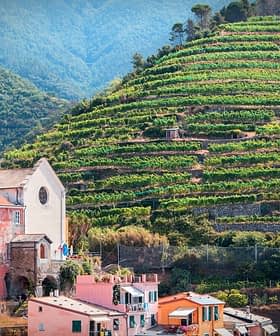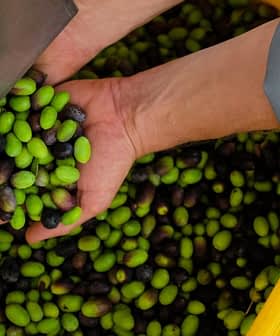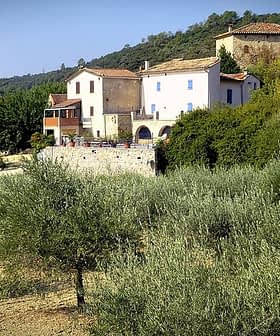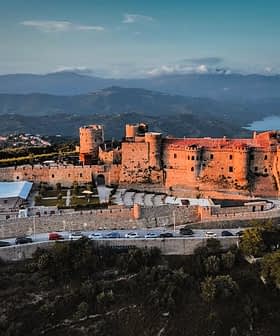The Categories of Olive Oil
The ambiguity in the term “olive oil” has long confused consumers and enriched disingenuous actors.
 11K reads
11K readsThe ambiguity in the term “olive oil” has long confused consumers and enriched the world of disingenuous actors.
To the unanointed, olive oil is all-encompassing.
It comes in $40 bottles from boutique specialty stores in the world’s most cosmopolitan cities. Meanwhile, five-liter tins gather dust on deli floors in sleepy towns.
See Also:Olive Oil BasicsThousands of kilometers away, drums, totes and flexitanks — emblazoned with the same two words — travel across the oceans on massive container ships.
To add to the confusion, in most supermarket aisles olive oil is usually combined with a series of prefixes.
These range from the extravagant (ultra-premium) to the mundane (pure) to the truly cryptic (polyphenol-rich).
But what do these prefixes actually mean? The short answer: nothing.
Who gets to define what olive oil is?
The only olive oil prefixes to which consumers should pay any attention are those laid out by the five major olive oil regulating authorities: the Codex Alimentarius, International Olive Council (IOC), European Union, United States Department of Agriculture (USDA) and Australian authorities.
There are many other national authorities that have formally legislated olive oil standards and grades too, but they largely follow the groundwork laid by the five aforementioned regulators.
As with rules governing most foods, the first technical definitions of olive oil were laid out by the United Nations Food and Agriculture Organization in the Codex Alimentarius.
Originally, the Codex Alimentarius defined four separate olive oil grades: olive oil, virgin olive oil, refined olive oil and refined olive-pomace oil. Most regulatory authorities worldwide have based their own olive oil standards and grades on these original four.

How is olive oil defined?
From the four grades of olive oil laid out in the Codex Alimentarius, nine different categories of olive oil and olive-pomace oil are defined by the IOC.
However, in the European Union, which is responsible for more than three-quarters of global production, this figure drops to eight.
These categories fall into three separate groups:
- Virgin oils for consumption;
- Blended or refined olive oil and pomace oil and virgin olive oils fit for consumption;
- Olive oil not fit for consumption
While there is broad agreement internationally about the different olive oil categories, their definitions change based on where the olive oil is produced. However, it is important to note that olive oil labels must accurately reflect the appropriate category in the country where the oil will be sold.
Virgin oils
Virgin olive oils are obtained solely by mechanical or other physical means under thermal conditions that do not alter the chemical composition of the oil. The only treatment that the olives and oil undergo are washing, decantation, centrifugation and filtration.
1. Extra virgin olive oil
The Codex Alimentarius, IOC, the USDA and Australian authorities define extra virgin olive as having an excellent flavor and odor with the median of defects – the median score of one of the 12 olive oil defects, which is perceived with the greatest intensity – as zero and the median of fruitiness above zero. EVOO also has a free fatty acid content expressed as oleic acid less than 0.8 grams per 100 grams.
While most governments around the world adhere to the standards set out in the Codex Alimentarius, the definition for extra virgin olive oil is more strict in California, which permits a free fatty acid content expressed as oleic acid less than 0.5 grams per 100 grams. However, the organoleptic requirements remain the same.
2. Virgin olive oil
The Codex Alimentarius, IOC and E.U. define virgin olive oil as having a reasonably good flavor and odor with the median of defects between zero and 3.5, with the median of fruitiness attribute above zero. The free fatty acid content, expressed as oleic acid, is less than two grams per 100 grams.
The USDA and Australian authorities have slightly stricter organoleptic requirements, with the median of defects between zero and 2.5 with the median of fruitiness attribute above zero. The free fatty acid content remains the same.
3. Ordinary virgin olive oil
The Codex Alimentarius, IOC and Australian authorities define ordinary virgin olive oil as having a median of defects between 3.5 and six, with a median of fruitiness above zero. The free fatty acid content, expressed as oleic acid, must be less than 3.3 grams per 100 grams.
Ordinary virgin olive oil is not very common as it may only be sold directly to consumers in countries where the category is recognized.
Blended of refined olive oil and olive pomace oil and virgin olive oils fit for consumption
4. Refined olive oil blended with virgin olive oils (olive oil, in the U.S.)
The Codex Alimentarius, E.U., IOC, Australian authorities and USDA define this category of olive oil as comprising a blend of refined olive oil with virgin olive oils fit for consumption.
The final blend of the two has a free acidity, expressed as oleic acid, of less than one gram per 100 grams. Its organoleptic characteristics correspond to virgin olive oil but may vary depending on individual regulations in each country.
5. Olive pomace oil composed of refined olive-pomace oils and virgin olive oils
Olive pomace oil is obtained by extracting the last remaining droplets of oil from olives that have already been mechanically transformed. The process usually involves chemically extracting the oil with powerful solvents before evaporating these out of the final product and deodorizing the resulting oil.
The Codex Alimentarius, E.U., IOC and USDA define olive pomace oil as comprising a blend of refined olive pomace oil and virgin olive oils fit for consumption. Free fatty acid content must be less than one gram per 100 grams.
In Australia, authorities have slightly more strict requirements, also requiring olive pomace oils to have the same organoleptic standards as virgin olive oil, a median of defects less than or equal to 2.5.
Olive oil not fit for human consumption
6. Lampante virgin olive oil
The Codex Alimentarius and IOC broadly define lampante virgin olive oil as an olive oil obtained solely by mechanical methods that is not fit for human consumption. Its free fatty acid content, expressed as oleic acid, is more than 3.3 grams per 100 grams. Its organoleptic characteristics also have a median of defects greater than six and a median of fruitiness of zero. These types of oils are typically sent to be refined and then blended.
However, the USDA and Australian authorities have a slightly stricter definition for lampante virgin olive oil. They define the product as having a median of defects between 2.5 and 6 or a median of defects less than or equal to 2.5 with a median of fruitiness of zero. Free fatty acid content, expressed as oleic acid, must be less than two grams per 100 grams.
The E.U. has very similar rules to the USDA and Australia, only differing in that the median of defects must be above 3.5 or the median of defects must be less than or equal to 2.5 with a fruitiness of zero.
7. Refined olive oil
The Codex Alimentarius, E.U., IOC, Australian authorities and USDA define refined olive oil as having been obtained from virgin olive oils using refining methods that do not alter the initial glyceridic structure, esters comprising glycerol and fatty acids. The free fatty acid content, expressed as oleic acid, is less than 0.3 grams per 100 grams.
8. Crude olive pomace oil
The Codex Alimentarius, E.U., IOC and USDA define crude olive pomace oil as the product obtained by extracting the last remaining droplets of oil from olives that have already been mechanically transformed. The process usually involves chemically extracting the oil with powerful solvents before evaporating these out of the final product and deodorizing the resulting oil.
9. Refined olive pomace oil
The Codex Alimentarius, E.U., IOC and USDA define refined olive pomace oil as being obtained from crude olive pomace oil using methods that do not lead to alterations in the initial glyceridic structure. It has a free fatty acidity, expressed as oleic acid, of not more than 0.3 grams per 100 grams.
The main takeaways
Shopping for olive oil should not be as hard as it is. Really, most consumers are in the market for either an extra virgin, virgin or refined olive oil blended with virgin olive oil.
When shopping for olive oil, pay no heed to the myriad prefixes adorning ornate labels. Simply pay attention to the terms “virgin” and “extra virgin.” Any other prefixes – with the exception of “organic” – are utterly meaningless (no matter what the YouTube videos say).
Extra virgin and virgin olive oils are more expensive than a blend of refined and virgin olive oils, which usually will not be labeled “refined olive oil blended with virgin olive oil.”
However, any labeling description from plain “olive oil” to “pure olive oil,” “light olive oil,” “premium olive oil” or “fresh olive oil” is simply a blend of refined and virgin olive oils.
Caveat emptor.








